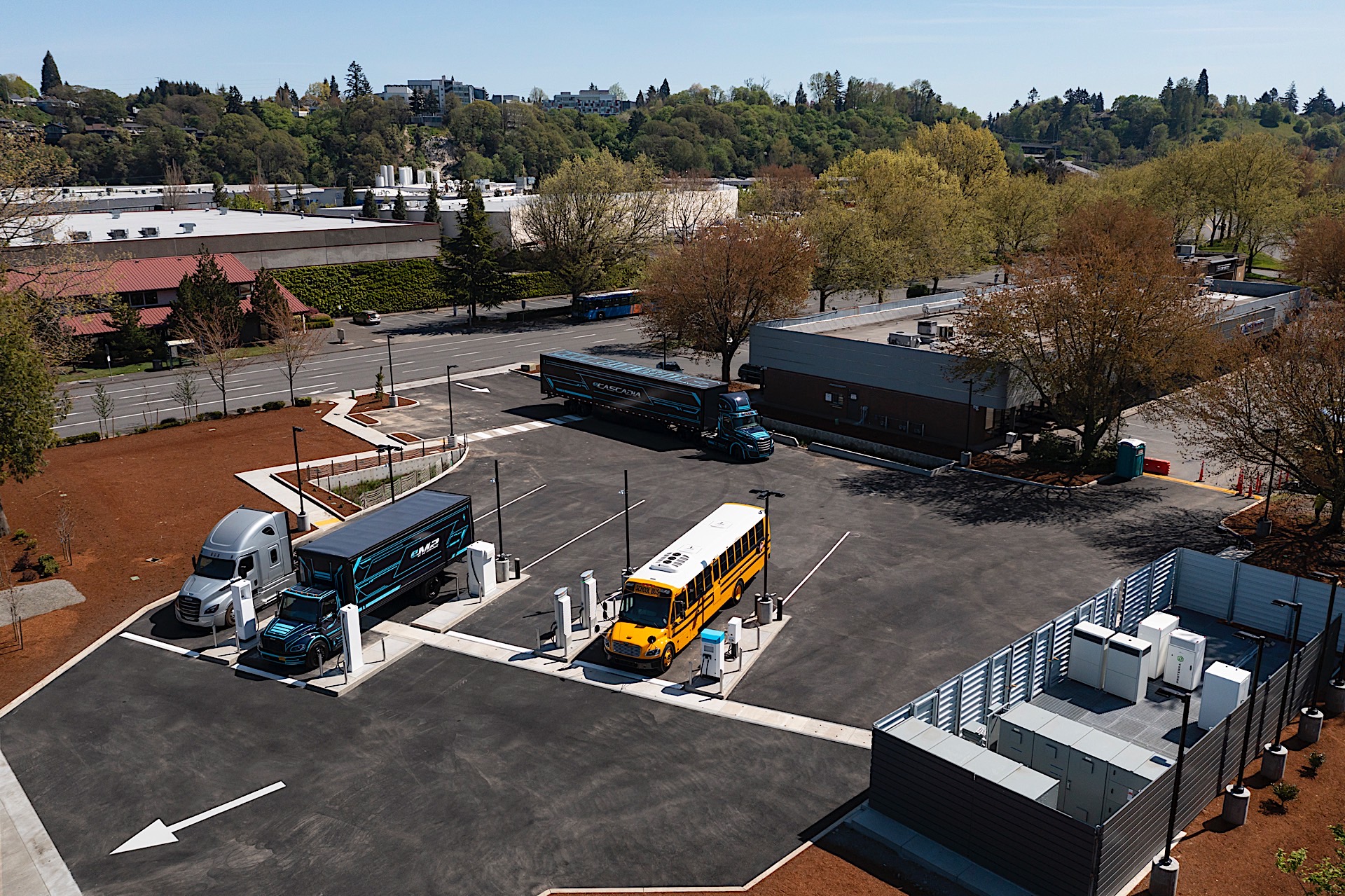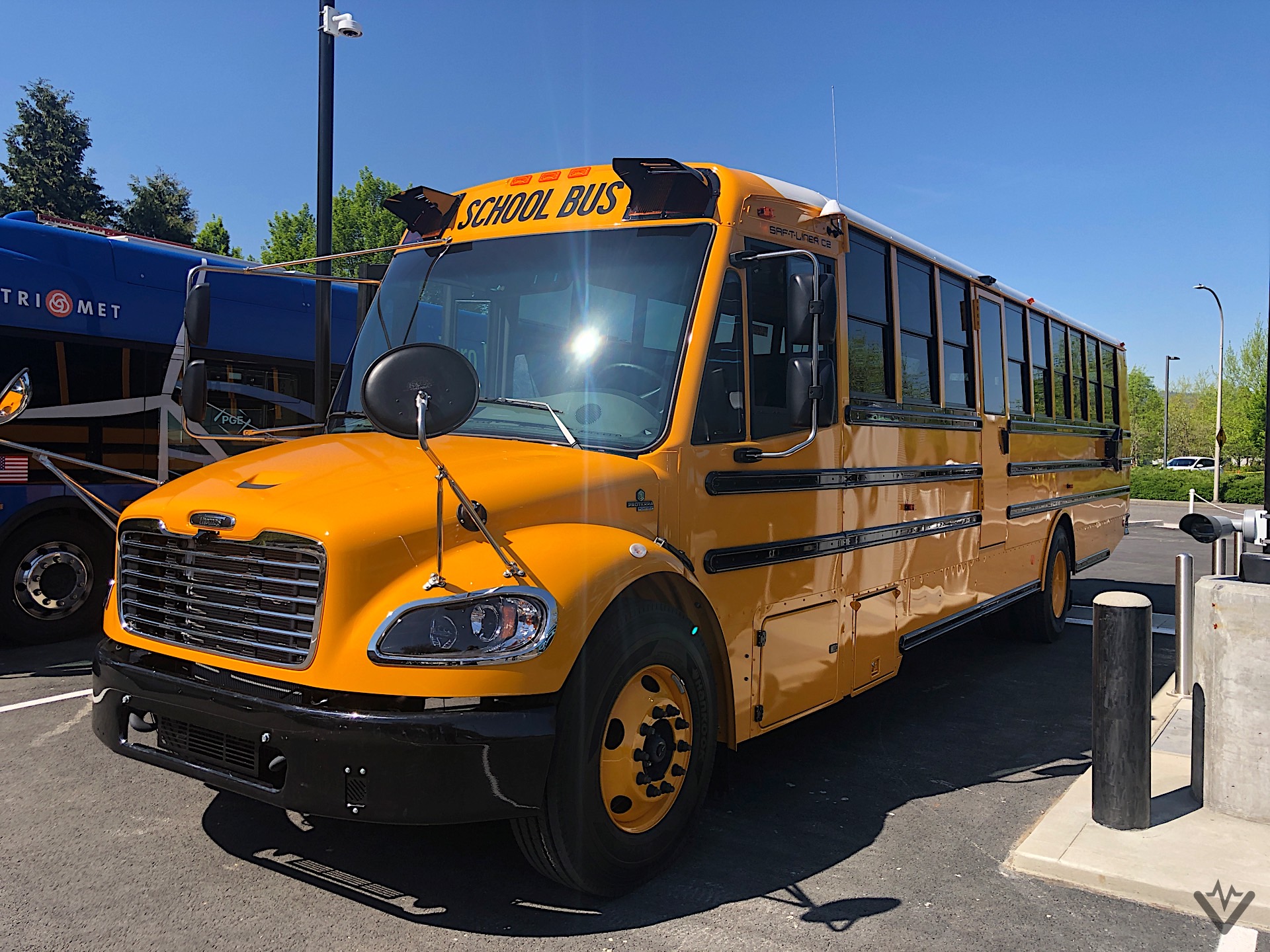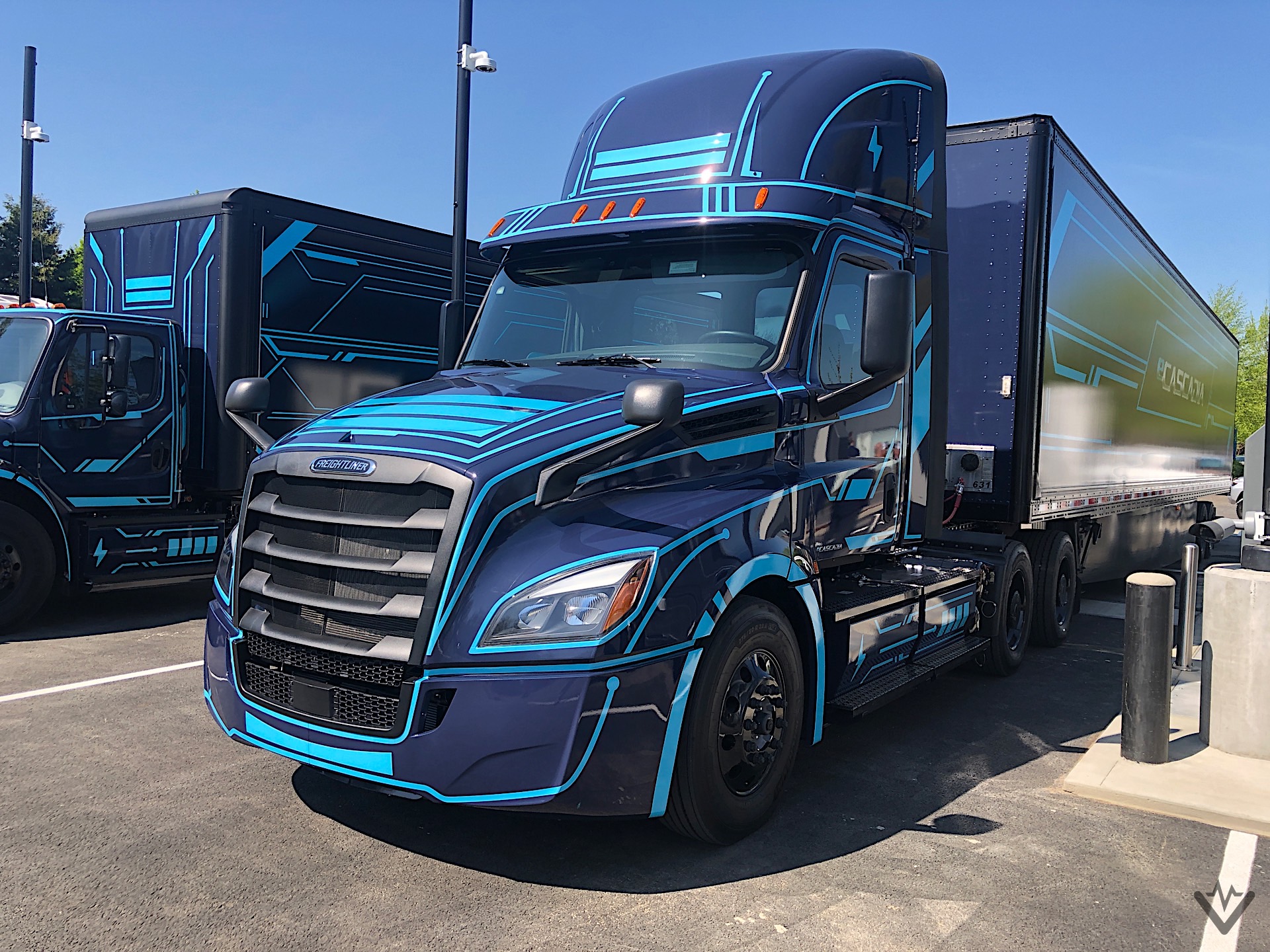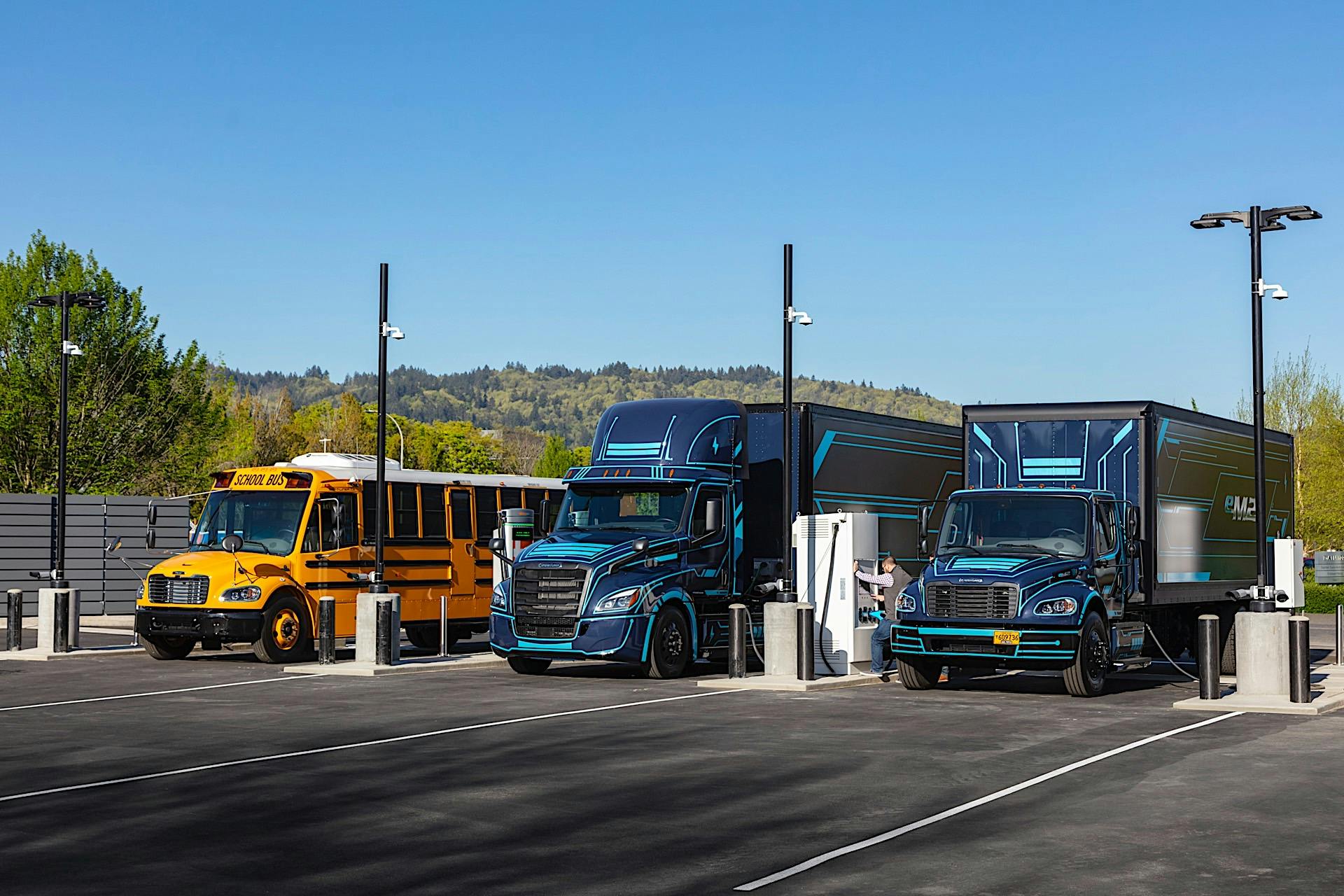Daimler Trucks North America and Portland General Electric have launched a new charging site in Portland, Oregon. The site, called “Electric Island” in reference to its location in Portland’s Swan Island industrial district, is designed to be the first of a new generation of charging centers that will allow Medium- and Heavy-Duty commercial electric trucks to recharge conveniently.
“The future of transportation is electric,” said Maria Pope, President and CEO of Portland General Electric. “We’re envisioning a better future for the next generation, and it’s going to take all of us to work together.”

The Electric Island installation includes eight vehicle charging stations suitable for charging electric cars, buses, box trucks, and semi-trucks, and will be open to public charging. Several different charging networks and plug configurations are included, and all chargers at the site feature DC fast charging. The site is designed to serve as an innovation center, allowing both PGE and Daimler to study energy management, charger use and performance, and, in the case of Daimler, its own vehicles’ charging performance.
“We’re providing a benefit to local EV drivers as well as those traveling up and down Interstate 5,” said John O’Leary, President and CEO of Daimler Trucks North America. “Together, we’ve installed the first purpose-built public station anywhere in the nation intentionally designed for the recharge of medium and heavy-duty electric vehicles.
Electric Island is located less than one mile from Interstate 5 as it passes through Portland. The site represents the first location specifically designed according to the blueprint of the West Coast Clean Transit Corridor Initiative (WCCTCI). WCCTCI’s 2020 collaboration between nine electric utilities and two government agencies yielded a strategic plan to electrify 1,300 miles of I-5, along the west coast to provide publicly available charging for freight and delivery trucks.
Nate Hill, head of charging infrastructure for Daimler, explained the scope of the site. “We are bringing five megawatts of power onto the site from the grid,” Hill said. “We don’t have all that power being used yet, but that’s what the site is capable of supporting.”
The ample power supply will be used to charge the biggest EVs on the road.
“We will have both 400- and 800-Volt charging here, and some of the units will go to 1,000 volts. Currently the highest-power unit we have installed here is 150 Kilowatts, but it can go up to 350 kilowatts.”
The “Jouley” Electric School Bus

Daimler also used the event to show off its upcoming all-electric products being developed under the company’s Freightliner and Thomas Built brands.
“At Daimler Trucks, we’re deeply committed to leading the delivery of battery electric commercial vehicle solutions,” O’Leary said, “For 135 years we’ve led our industry through innovation as well as collaboration and cooperation. We have the same blueprint in mind as we navigate our path forward to our goal of selling exclusively CO2-neutral vehicles by 2039. We started our e-mobility product development roughly three years ago to achieve that 2039 goal.”
The program has already launched with a line of all-electric school buses currently being field-tested across North America.
“Last year we started delivering the all-electric school bus, the Thomas Built Buses Saf-T-Liner C2 Jouley,” O’Leary said. “This school bus is in the hands of school districts across the country from Tok, Alaska to Beverly, Massachusetts, with more on the way.”
Freightliner eCascadia and eM2

Daimler had both its Freightliner eCascadia electric semi-truck and its eM2 box truck on display at Electric Island to highlight the uses of the station and the company’s vision of heavy electric commercial vehicles.
“The eCascadia is our heavy-duty electric product,” explained Alexander Voets, e-mobility sales and marketing manager for Daimler Trucks North America. “It’s the electric version of the Freightliner Cascadia that we have on the road today. It’s built on the same platform but of course there is no engine, no transmission, and no after-treatment system with diesel exhaust fluid. Instead we have battery packs, inverters, and electric axles. This is a full class 8 truck, so it has 80,000-pound capacity. With a 475 kWh battery pack, it has a range of up to 250 miles. We have almost 40 of these trucks on the road today, and we’re going into production with this vehicle at the end of 2022.”
In addition to the eCascadia, Daimler also displayed its eM2 box truck. As a Class 6/7 truck, it’s smaller than a semi, and similar to trucks commonly used for furniture or appliance deliveries today.
“The eM2 is the electrified version of the M2 product in Class 6 and 7,” Voets said, “With a 315 kWh battery pack, this truck will have a range of about 230 miles. It will go into production about 6 months after the eCascadia.”
With their range estimates, Daimler expects both these trucks to see extensive use within urban areas rather than cross-country long-distance applications.
“These are for drayage applications; pickup and delivery, and regional delivery,” Voets said. “That’s really what these trucks are designed to do. It’s not the right application for every use case, but some applications are very good.”
Most urban-area delivery trucks in classes 6-8 work from a central warehouse and make deliveries to retail locations within a given metropolitan region. Daimler’s customer research indicates that most trucks working in this method actually travel less than 100 miles per day, making the Freightliner products well-suited to the needs of operators.
As part of the event, participants were invited to take a ride in each of the electric trucks. As is typical of electric vehicles, acceleration was impressive and road noise was almost nonexistent. Both the eCascadia and eM2 offer driver-adjustable regeneration controls near the steering wheel to minimize use of the brake pedal, in place of the noise-polluting engine brake found on diesel-engine trucks.
While Daimler has not yet announced pricing on the electric trucks, Voets emphasized the need for government support.
“You can expect that new technologies will be significantly more expensive, so incentives and grants really are necessary to overcome these initial investments on the vehicle and the charging side,” he said. “Incentives are really there to accelerate the adoption and deployment of electric trucks.”

